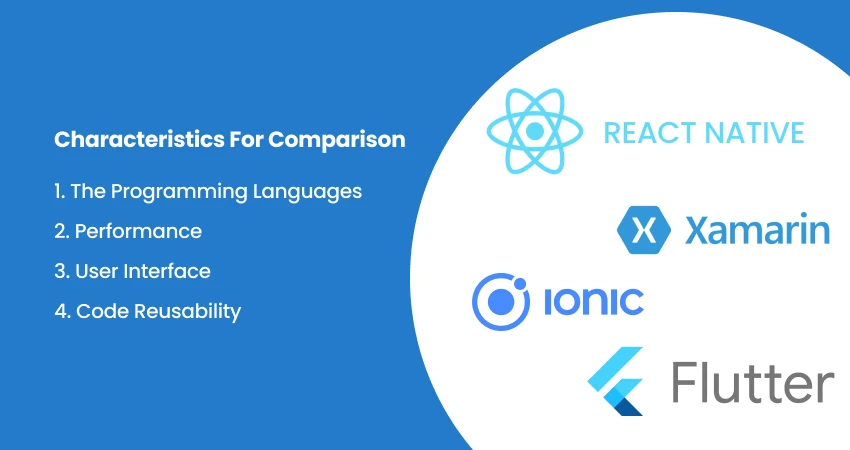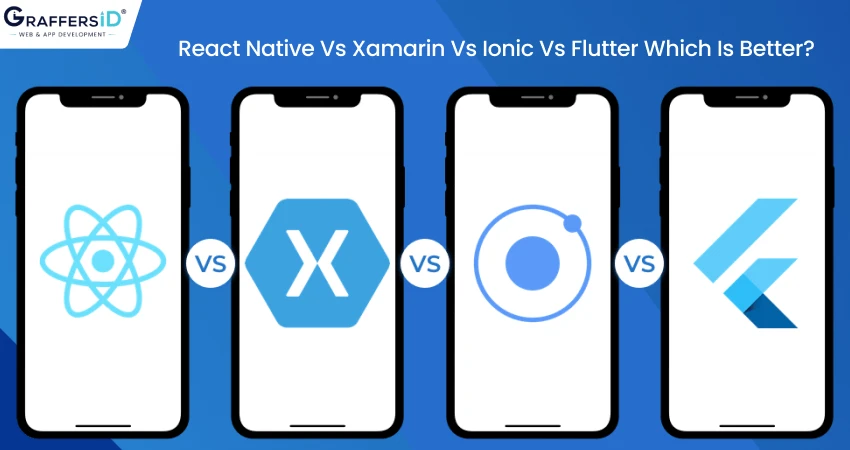So you are confused about choosing the right frameworks i.e. React Native vs Xamarin vs Ionic vs Flutter for the development of your cross-platform app in 2024? Don’t worry, GraffersID is here to resolve all your queries and help you select the best between flutter vs react native vs xamarin vs ionic. For that, you need to check out the detailed blog. Don’t miss it.
Introduction
Generally, when developing a mobile application, you decide the platform on which you want to launch the app, which can be either Android or iOS. IOS apps are developed using Objective-C and Swift, while Java is used for Android apps. On the other hand, developers are using React Native, Xamarin, and Flutter for developing cross-platform apps.
Before launching the app, the developer develops the app to have a high-performance quotient. The process of developing the app becomes time-consuming and costly as the same code has to be written twice.
However, with cross-platform mobile app development, the developer just has to write one piece of code, which can work on both Android and iOS. It ends up saving time. But, the catch is those apps built on cross-platforms generally don’t perform well. They lack higher performance than native apps.
To resolve the issue, many expert developers use certain tools such as React Native, Xamarin, Ionic, and Flutter, which can enhance the performance of the app.
You might be wondering if all of these tools work best for cross-platform, then which would work best amongst them all? Don’t worry. In this article, we’ll dive into the comparison of all these tools i.e. React Native vs Xamarin vs Ionic vs Flutter.
We’ll also look at which one qualifies to be the best cross-platform framework in 2024 for building mobile applications by determining the characteristics of the tools.
What is React Native?
React Native is a popular open-source framework for building mobile applications using JavaScript and React, which are the same technologies used for building web applications. It was developed by Facebook and launched in 2015. React Native enables developers to create native mobile applications that run on both iOS and Android platforms with a single codebase.
Key Features:
- Cross-platform development
- High-performance
- Hot Reloading
- UI-focused
- Extensive library of pre-built components
- Third-party libraries and plugins
- Live updates
- Easy to learn and adopt.
What is Xamarin?
Xamarin is a cross-platform app development framework that uses the C# programming language and .NET framework. Here are the key features of Xamarin:
- Cross-platform development
- Uses a single, shared C# codebase for building apps for multiple platforms
- Native app performance
- Access to native APIs and platform-specific features
- Integration with Visual Studio, Microsoft’s integrated development environment (IDE)
- Large community support
What is Ionic?
Ionic is a popular open-source framework for building cross-platform mobile apps using web technologies such as HTML, CSS, and JavaScript. Here are the key features of Ionic:
- Cross-platform development
- Built on top of Angular, a popular web development framework
- Pre-built customizable UI components to create beautiful user interfaces
- Access to native device features and plugins through Cordova/PhoneGap
- Live Reload feature that allows for real-time updates during app development
- Ionic Creator, a drag-and-drop tool for building Ionic apps without coding
What is Flutter?
Flutter is an open-source mobile application development framework created by Google, using the Dart programming language. Here are the key features of Flutter:
- Cross-platform development
- High Performance, with fast development and rendering times
- Hot Reload feature for real-time updates during app development
- Access to native device features and APIs
- Built-in Material Design and Cupertino (iOS) widgets, allowing for beautiful and consistent app design across platforms
- Customizable widgets for building unique and complex UI designs
React Native vs Xamarin vs Ionic vs Flutter: Key Comparison[2024]

Before determining the best tools for the development of cross-platform mobile applications, let’s understand the characteristics on which we will compare these four tools:
1. The Programming languages
Let’s look at the languages and their benefits used by these four tools:
1. React Native: React Native uses JavaScript. JavaScript is a high-performing language and one of the most popular languages.
React Native combines the benefits of ReactJS and JavaScript. It’s also sponsored by Facebook.
It allows the developer to write components or modules in Objective-C, Java, and Swift. With the help of libraries and native modules, you can handle heavy operations such as video processing and image editing.
Also, you can handle unconventional operations that are not included in the framework API. Your team should have the basic idea of these platforms to build modules and connect them to JavaScript.
2. Ionic: The Ionic framework uses JavaScript, CSS, and HTML5 and requires a Cordova wrapper to use the native platform controllers. The Ionic core is based on AngularJS, which is a popular JavaScript framework and is written in SaaS.
The main language of Ionic is TypeScript, which is a syntactical subset of JavaScript. Typescript helps to identify and eliminate mistakes, which improves the quality of the code.
3. Xamarin: Xamarin uses programming C# and .NET to develop Mac, Android and iOS applications. With C #, a developer can achieve anything using Xamarin and C #.
Generally, developers can’t use native open-source libraries for IOS and Android. However, they can use.net libraries to bridge the gap and meet such requirements.
4. Flutter: Flutter uses Dart for IOS and Android app development and can be used to build high-quality applications. Developers can build various apps using Flutter.
2. Performance
Performance is a crucial factor to consider when building mobile applications. It shows how apps will perform when different frameworks are used.
1. React Native: Its app performance is quite similar to other native apps as it uses the elements of the code that are for the React Native API. React Native enables developers to use native modules when they want to script code for complex operations.
If you want to hire dedicated React JS developers for your project, Consult GraffersID, a leading IT staff augmentation company.
Since the native modules are scripted in native languages, it makes it easier and more accessible for developers. These native modules provide high performance. However, the drawback is that it cannot be utilized on other platforms.
2. Xamarin: Xamarin’s performance is quite similar to native performance. You can develop mobile applications in two ways with Xamarin, Xamarin.forms, Xamarin.android, and Xamarin.IOS.
The applications were developed with xamarin.android and xamarin.ios work similarly to native apps, and the cross-platform functionality of the apps is based on business logic rather than codebases. Also, you get high performance as native apps.
While xamarin.forms are focused on broad code sharing, It’s less platform-specific, which reduces the performance of the code when compared to pure native and Xamarin native.
3. Ionic: Ionic doesn’t offer similar performance to native apps. Although it doesn’t use native components, its appearance is quite similar to native apps, which are done through web technologies. The silver lining of using Ionic is that the app testing happens rapidly, which streamlines and makes it stand out in the process of app development.
4. Flutters: Undeniably, Flutters tops all of the other apps in performance. It offers great speed as it uses darts.
3. User Interface
The user interface should be engaging and simple to grab the attention of the users.
1. React Native: Its modules interact with native UI controllers that enhance the UI, similar to native apps. Also, it utilizes ReactJS libraries for UI development.
2. Xamarin: When developing UI in Xamarin, you can use both Xamarin.android and Xamarin.ios. Developing UI using Xamarin.android and iOS is time-consuming but will look similar to native apps.
While in Xamarin.forms, it consumes less time and the development process becomes easier. However, the development might not look similar to native apps. This development is generally used by corporate ventures where UI isn’t given much priority.
3. Ionic: Ionic develops UI using CSS and HTML and doesn’t use its native elements. In fact, it uses Cordova to get a native look. At present, Ionic has a new native UI layout and elements that weren’t there before. They are only available on Android and IOS with a native SDK.
4. Flutter-Flutter aces the UI amongst them all. In comparison with react native, both flutter and react native have great efficiency and high performance.
4. Code Reusability
Code reusability gives you an idea of how you can reuse the existing code for both platforms.
1. React Native: React Native uses native components in Swift, Objection-C, and Java to enhance the app’s performance. Generally, ninety percent of these components can be reused on other platforms, and the rest of the native components in the codebase have to be accepted. The developers have to change a specific codebase.
2. Xamarin: In Xamarin, ninety-six percent of the source code with xamarin.form can be reused. In fact, it enhances and speeds up the development process.
3. Ionic: Generally, Ionic works well on every OS platform. However, some components have to be changed according to the platforms, for which you have to put in the extra effort.
4. Flutter: In React Native, there’s an always ready-to-use function that enhances the speed of development. While in Flutter, you need to add dedicated files on both the Android and iOS platforms, which depend on the rules.
Common Difference Between React Native vs Xamarin vs Ionic vs Flutter
| Aspect | React Native | Xamarin | Ionic | Flutter |
|---|---|---|---|---|
| Development Language | JavaScript and React | C# and .NET | HTML, CSS, JavaScript | Dart |
| Platform Targeting | Android, iOS, Web | Android, iOS, macOS, TV, watchOS | Android, iOS, Web, PWA | Android, iOS, Web, Fuchsia, Embedded |
| Code Reusability | High | High | High | Very High |
| Performance | Near-native | Near-native | Web-based (can be slower) | Near-native |
| Community & Ecosystem | Large and Active | Moderate | Moderate | Growing |
| Learning Curve | Moderate | Moderate | Low | Moderate |
| UI Components | Native-like | Native | Web-based | Customizable Widgets |
| Development Speed | Fast | Moderate | Fast | Very Fast |
| Hot Reload | Yes | Yes | Yes | Yes |
| Integration with Native Code | Yes | Yes | Limited | Yes |
| Native Modules | Available | Available | Limited | Available |
| IDE Support | Any text editor, VS Code | Visual Studio, VS Code, Xamarin Studio | Any text editor, VS Code | Android Studio, VS Code, IntelliJ IDEA |
| Licensing | Open source (MIT) | Proprietary (Commercial) | Open source (MIT) | Open source (BSD-style) |
| Community Support | Microsoft | Community | ||
| Popular Apps Built with it | Facebook, Instagram, Airbnb | Xamarin.Forms, UPS, Alaska Airlines | Pacifica, Diesel, Sworkit | Google Ads, Alibaba, Reflectly |
| Development Environment | React Native CLI, Expo (optional) | Visual Studio, Visual Studio for Mac | Ionic CLI, Capacitor | Flutter CLI |
| State Management | Redux, MobX, Context API | MVVM, Prism, Xamarin.Forms | Angular services, RxJS | Provider, Bloc, MobX, Redux |
| UI Theming and Styling | Stylesheets (CSS-in-JS), Styled Components | XAML, Stylesheets, Native UI Components | Stylesheets (CSS), Ionic CSS utilities | Customizable Widgets, ThemeData |
| Community Packages | NPM (React Native libraries) | NuGet (Xamarin packages) | NPM (Ionic libraries) | Pub (Flutter packages) |
| Testing Frameworks | Jest, Detox, Appium | Xamarin.UITest, Appium, Calabash | Jasmine, Karma, Protractor | Widget testing, Integration testing |
| Popularity Trends (GitHub Stars) | ~98k | ~18k | ~47k | ~155k |
| Maturity Level | Mature | Mature | Established | Rapidly Evolving |
Pros and cons of Flutter vs. React Native vs. Xamarin vs. Ionic
To make an informed decision for your next project, it’s crucial to delve deeper into the pros and cons of each of these frameworks.
Pros and Cons of Flutter:
Pros:
- Fast Development: Flutter’s standout feature is its hot reload capability, which allows developers to see real-time changes, making the development process remarkably efficient.
- Single Codebase: Flutter employs a single codebase for iOS and Android, simplifying development and minimizing redundancy.
- Stunning UIs: Flutter offers a plethora of pre-designed widgets and customizable UI components, ensuring visually appealing and unique app interfaces.
- High Performance: By compiling to native ARM code, Flutter ensures high performance, silky-smooth animations, and a lag-free user experience.
- Booming Community: Flutter boasts a rapidly expanding community, extensive documentation, and a growing repository of third-party packages for added functionality.
Cons:
- Large App Size: Flutter applications can be on the bulkier side compared to fully native counterparts, which might pose storage issues for some users.
- Limited Libraries: While Flutter’s library ecosystem is continuously growing, it might not match the vast selection available for more mature frameworks.
- Learning Curve: Developers not familiar with Dart (the language used by Flutter) may face a learning curve, potentially slowing down project initiation.
Pros and Cons of React Native:
Pros:
- JavaScript Familiarity: React Native’s primary advantage is its use of JavaScript, a widely adopted language, making it accessible to a broad developer base.
- Rich Ecosystem: Benefit from a vast ecosystem of libraries and pre-built components, saving time and effort during development.
- Native Performance: By running on a native thread, React Native can achieve near-native performance, a crucial factor for demanding applications.
- Solid Backing: React Native is developed and maintained by Facebook, offering robust support, frequent updates, and a long-term outlook.
- Thriving Community: A substantial and active community ensures abundant resources, tutorials, and a diverse collection of third-party packages.
Cons:
- Bridge Overhead: Communication between JavaScript and native modules can introduce performance bottlenecks, particularly in complex applications.
- Fragmentation Challenges: Differences between iOS and Android may lead to fragmentation issues, necessitating platform-specific code in some cases.
- Customization Complexity: Customizing native components in React Native can be challenging, requiring a deep understanding of native code.
Pros and Cons of Xamarin:
Pros:
- Native Performance: Xamarin’s standout feature is its ability to provide near-native performance by enabling developers to write code in C# and access native APIs directly.
- Shared Codebase: Xamarin allows developers to share a significant portion of code across platforms, reducing development time and effort.
- Microsoft Integration: Backed by Microsoft, Xamarin seamlessly integrates with Visual Studio and Azure services, making it an ideal choice for enterprises.
- Robust Ecosystem: Xamarin enjoys a well-established ecosystem and a strong developer community, offering a wealth of resources.
- Native UI Options: Developers can opt for Xamarin.Forms for shared UI or choose platform-specific UI development, offering flexibility based on project requirements.
Cons:
- Learning Curve: Developers new to C# or Xamarin may face a learning curve, potentially delaying project commencement.
- Larger App Size: Xamarin applications tend to have a larger footprint compared to purely native apps, which may concern users with limited storage.
- License Costs: While Xamarin offers a free version, some advanced features and tools may require a paid license, affecting budget considerations.
Pros and Cons of Ionic:
Pros:
- Leveraging Web Technologies: Ionic uses familiar web technologies like HTML, CSS, and JavaScript, making it particularly accessible to web developers.
- Cross-Platform Development: Ionic simplifies the process of creating apps for multiple platforms, minimizing development time and costs.
- Native Access: Ionic provides access to native device features through plugins, ensuring that developers can incorporate essential functionalities.
- Rapid Development: The Ionic CLI and a vast selection of pre-designed UI components enable developers to build apps quickly and efficiently.
- Active Community: An active community and a marketplace for plugins and extensions provide valuable resources for Ionic developers.
Cons:
- Performance Constraints: Ionic apps may not perform as optimally as fully native applications, especially for graphics-intensive or resource-demanding tasks.
- Limited Native Feel: Achieving a truly native look and feel can be challenging with Ionic, potentially impacting the user experience.
- Dependency on Plugins: Ionic relies heavily on plugins for incorporating native functionality, which can lead to compatibility issues and potential maintenance challenges.
Development Cost For Flutter, React Native, Xamarin, and Ionic
The development cost for mobile app development using Flutter, React Native, Xamarin, and Ionic can vary significantly based on various factors such as the complexity of the app, the experience of the development team, the geographic location of the development team, and more. Here, we provide a general estimate of the development cost for a simple mobile app using each of these frameworks.
- Flutter:
- Development Cost: $10,000 to $30,000
- Flutter is known for its fast development and good performance. It can reduce development costs due to its single codebase for both Android and iOS.
- React Native:
- Development Cost: $10,000 to $35,000
- React Native also offers a cost-effective solution with a single codebase. Costs can vary depending on the complexity of the app and the need for custom native modules.
- Xamarin:
- Development Cost: $15,000 to $40,000
- Xamarin allows you to share code across platforms, but it may require more effort for platform-specific UI components, which can increase costs.
- Ionic:
- Development Cost: $8,000 to $25,000
- Ionic is a good choice for simpler apps, and it often results in lower development costs. However, if the app requires extensive native features, costs can increase.
Which framework is better for cross-platform mobile app development in 2024?
However, based on current trends, it seems that Flutter is gaining popularity and is becoming a popular choice among developers for cross-platform mobile app development. This is due to its fast development times, high performance, and beautiful and customizable UI designs.
That being said, React Native and Xamarin are well-established frameworks with large communities and have been used to build many successful cross-platform mobile apps. Ionic, on the other hand, is also a great choice for web developers who want to use web technologies to build mobile apps.
Ultimately, the best framework for cross-platform mobile app development will depend on the specific needs of the project, the skillset of the development team, and other factors such as budget and timeline. It’s important to carefully evaluate the strengths and weaknesses of each framework before making a decision.
Conclusion
Generally, these frameworks are used to minimize the cost and time required for app development. Each framework has its own merits and demerits.
Flutter and Native provide excellent native-like experiences, while Xamarin offers two mobile development approaches, Xamarin.android/IOS and Xamarin.forms, while Ionic offers excellent coding quality.
Choosing the best framework amongst them highly depends on your app requirements.
Get In Touch With Us
[quform id=”1″ name=”Contact Form Footer”]




